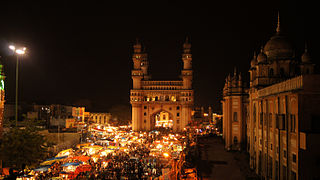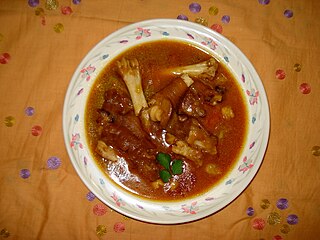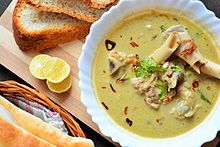
Hyderabad is the capital and largest city of the Indian state of Telangana. It occupies 650 km2 (250 sq mi) on the Deccan Plateau along the banks of the Musi River, in the northern part of Southern India. With an average altitude of 542 m (1,778 ft), much of Hyderabad is situated on hilly terrain around artificial lakes, including the Hussain Sagar lake, predating the city's founding, in the north of the city centre. According to the 2011 census of India, Hyderabad is the fourth-most populous city in India with a population of 6.9 million residents within the city limits, and has a population of 9.7 million residents in the metropolitan region, making it the sixth-most populous metropolitan area in India. With an output of US$74 billion, Hyderabad has the fifth-largest urban economy in India.
Indian cuisine consists of a variety of regional and traditional cuisines native to the Indian subcontinent. Given the diversity in soil, climate, culture, ethnic groups, and occupations, these cuisines vary substantially and use locally available spices, herbs, vegetables, and fruits.

Biryani is a mixed rice dish, mainly popular in South Asia. It is made with rice, some type of meat and spices. To cater to vegetarians, in some cases, it is prepared by substituting vegetables or paneer for the meat. Sometimes eggs and/or potatoes are also added.

Haleem is a type of stew that is widely consumed in South Asia, the Middle East and Central Asia. Although the dish varies from region to region, it optionally includes wheat or barley, meat and lentils. It is made by blending or mashing the meat in the curry and serving hot with flat breads or on its own. The original Haleem, which is different from this variety, is an ancient Iranian dish served with wheat, meat, cinnamon, and sugar that remains popular in Iran. Popular variations of haleem include keşkek in Turkey, Tajikistan, Uzbekistan, Azerbaijan and northern Iraq; harisa in the Arab world and Armenia; halim in Afghanistan, Iran, West Bengal, in Mauritius and Bangladesh; and khichra in Pakistan and India.

Hyderabadi biryani is a style of biryani originating from Hyderabad, India made with basmati rice and meat. Originating in the kitchens of the Nizam of Hyderabad, it combines elements of Hyderabadi and Mughlai cuisines. Hyderabad biryani is a key dish in Hyderabadi cuisine and it is so famous that the dish is considered synonymous with the city of Hyderabad.

Dried meat is a feature of many cuisines around the world. Examples include:

Chakna or chaakna is a spicy stew, originating from the Indian subcontinent, made out of goat tripe and other animal digestive parts. It is a speciality among Hyderabadi Muslims. In all other parts of India, chakna refers to any snacks/finger foods for consumption with alcohol. The tripe stew includes chunks of liver and kidneys. it's usually taken with liquors throughout India.

Dopiaza is the name of two separate dishes, one in the Greater Iran region and one in South Asia. It refers to a family of recipes, typically meat-based, that contain onions as a major ingredient. There are two alternative etymological explanations for its name.
- Onions are added at two stages of cooking: chopped or ground in the marinade/gravy, and as a garnish/topping, either pickled or crisply fried.
- The recipe uses onions and meat in a 2:1 ratio.

Sup kambing or sop kambing is a Southeast Asian mutton soup, commonly found in Brunei Darussalam, Indonesia, Malaysia, Singapore. It is prepared with goat meat, tomato, celery, spring onion, ginger, candlenut and lime leaf, its broth is yellowish in colour. Sup kambing is quite widespread as numbers of similar goat meat soup recipes can be found throughout Malaysia, Indonesia and Singapore.

Paya is a traditional food from South Asia. It is served at various festivals and gatherings, or made for special guests. Paya means 'leg'/'feet' in Hindi and Urdu languages. The main ingredients of the dish are the trotters (hooves) of a cow, goat, buffalo, or sheep, cooked with various spices.

Bun kebab or anda shami is a sandwich that originated in Pakistan, but is now popular all throughout the Indian subcontinent. Bun kebabs are a signature in Pakistani metro cities like Karachi and Lahore, but they can be found all over Pakistan. Bun Kebab vendors are scattered all across Karachi, vendors on Burns Road being particularly famous, and imitated by frozen bun kebabs sold in South Asian supermarkets across the world. In India, it is eaten as a regular street food, specifically, in the Indian cities of Bhopal, Lucknow, and Hyderabad; it is especially popular with Indian Muslims, the dish is eaten late-night during Ramadan. Bun kebabs are usually sold from roadside stalls, side street vendors, and fast food restaurants. They are also commonly known as anday wala burger. A ‘fried’ version of the bun kebab is popular in Lahore, known as ‘bun plaster’ due to copious amounts of butter and super tender or paste-like kebab mixture used in it. Bun kebabs are usually eaten as a main course or snack.

Hyderabadi cuisine, also known as Deccani cuisine, is the native cooking style of the Hyderabad, Telangana, India. The haute cuisine of Hyderabad began to develop after the foundation of the Bahmani Sultanate, and the Qutb Shahi dynasty centered in the city of Hyderabad promoted the native cuisine along with their own. Hyderabadi cuisine had become a princely legacy of the Nizams of Hyderabad as it began to further develop under their patronage.

Hyderabadi haleem is a type of haleem popular in the Indian city of Hyderabad. Haleem is a stew composed of meat, lentils, and pounded wheat made into a thick paste. It is originally an Arabic dish and was introduced to the Hyderabad State by the Chaush people during the rule of the Nizams. Local traditional spices helped a unique Hyderabadi haleem evolve, that became popular among the native Hyderabadis by the 20th century.

Lukhmi is a typical mince savoury or starter of the cuisine of Hyderabad, Telangana, India. It is a local variation of samosa. The snack's authentic preparation includes stuffing with mutton-mince kheema. It is a non-vegetarian derivative of the samosa although, unlike the latter, the lukhmi is shaped into a flat square patty.

Mirchi ka salan, or curried chilli peppers, is a popular Indian chilli and peanut curry from Hyderabad, Telangana, India, that usually accompanies Hyderabadi biryani alongside dahi chutney. The dish contains green chilli peppers, peanuts, sesame seeds, dry coconut, cumin seeds, ginger and garlic paste, turmeric powder, bay leaf, and thick tamarind juice.

Dalcha, is an Indian lentil-based stew originating from Hyderabad, Telangana, India. Its origins may lie with a similar middle eastern dish Harees which is more of a gruel with cooked meats. Primary ingredients are lentils, can be chana dal or sometimes tur dal. Vegetables or meats, both chicken or mutton may also be added to the stew, so if mutton is added it will be called a mutton dalcha. Bottle gourd is another key ingredient in a Dalcha. It is traditionally served with the rice dish called bagara khana.

The culture of Hyderabad, also known as Hyderabadi Tehzeeb or Dakhini Tehzeeb, is the traditional cultural lifestyle of the Hyderabadi Muslims, and characterizes distinct linguistic and cultural traditions of North and South India, which meet and mingle in the city and erstwhile kingdom. This blending was the result of the geographic location of the region and the variety of historical dynasties that ruled the city across different periods—its inception by the Qutub Shahi dynasty in 1591 AD, the occupation by the Mughal Empire and its decline, and the patronage under the Asaf Jahi dynasty.

The Thalassery cuisine refers to the distinct cuisine from Thalassery city of northern Kerala, which has blended in Arabian, Persian, Indian and European styles of cooking as a result of its long history as a maritime trading post.

















